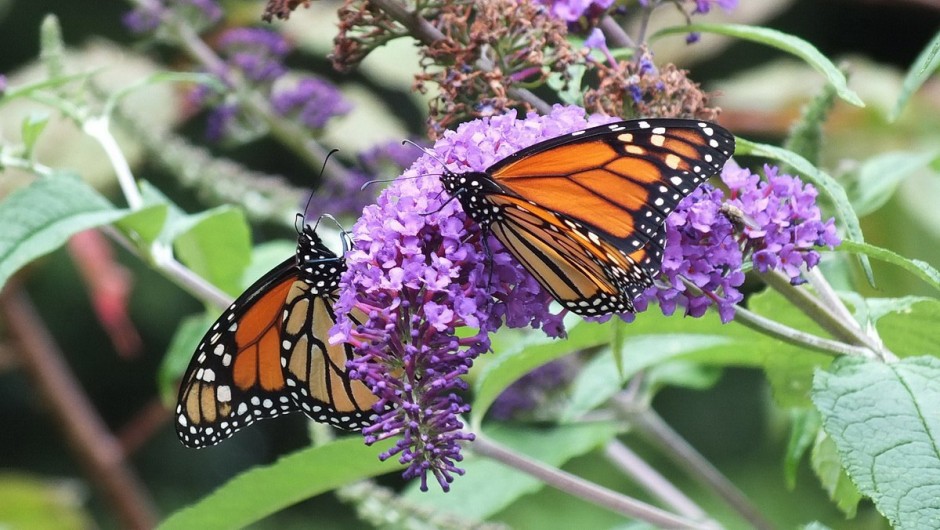Butterflies are beautiful flying insects to see flutter throughout the garden, they fascinate the young, the old and every age in between. Creating a habitat for them can be fun, exciting and important part in their survival!

- Plant native flowering plants - For decades butteflies have eaten and used native plants for their needs of laying eggs, forming crysalists and protection from the elements. So they are always a good choice to use.
- Plant type and color is important - Adult butterflies are attracted to red, yellow, orange, pink and purple blossoms that are flat-topped or clustered and have short flower tubes. So plants like Pentas (annual), Heliotrope (annual), Butterfly weed (perennial), Achillea (perennial) are what you are looking for.
- Plant good nectar sources in the sun - Butterflies usually feed in the full sun (mid-morning and on), due to them needing to warm their wings to take flight.
- Plant for continuous bloom - Find plants that bloom continuously from spring to a hard frost. Annuals are the best suggestion to fulfill this. There are some perennials that may re bloom throughout the season sporadically, or plant perennials that bloom in Spring, Summer and Autumn to fulfill continuous flowering.
- Say no to insecticides - Insecticides can not determine which bugs/ insects you want to get rid of verses the ones you want to keep. Even home remedies can hurt good bugs and insects. Just remember if you decide to not use insecticides you may find an increase in all bugs.
- Feed butterfly caterpillars - If you don't "grow" caterpillars, there will be no adults. Bringing caterpillar foods into your garden can greatly increase your chances of attracting unusual and uncommon butterflies, while giving you yet another reason to plant an increasing variety of native plants. In many cases, caterpillars of a species feed on only a very limited variety of plants so bulk up on some proven plants they do eat. Most butterfly caterpillars never cause the leaf damage we associate with some moth caterpillars such as bagworms, tent caterpillars, or gypsy moths.
- Provide a place for butterflies to rest - Since Butterfly wings are made up of tiny little scales they need the warmth of the sun to fly. Butterflies also need safe places to rest and take cover in bad weather. To accomplish this put some flat stones around and through out the garden in full sun to make it inviting for Butterflies to come eat, get warm and take a rest.
- Give them a place for puddling - Butterflies often congregate on wet sand and mud to partake in "puddling," drinking water and extracting minerals from damp puddles. Place coarse sand in a shallow pan and then insert the pan in the soil of your habitat. Make sure to keep the sand moist.
There are more plants than what is on this list that will attract Butterflies:
Flowering:
Aster (Aster spp.)
Black-Eyed Susan (Rudbeckia hirta)
Butterfly Milkweed (Asclepias tuberosa)

Common Milkweed (Asclepias syriaca)
Coneflowers (Echinacea purpurea)
False Nettle (Boehmeria cylindrica)
Hollyhock (Alcea rosea)
Indian Paintbrush (Castilleja spp.)
Mallow (Malva spp.)
Nasturtium (Tropaeolum majus)
Pussy-toe (Antennaria plantaginifolia)
Rue (Ruta graveolens)
Ruellia (Ruellia spp.)
Shasta Daisy (Leucanthemum spp.)
Silver Brocade (Artemisia stellariana)
Snapdragon (Antirrhinum majus)
Salvia
Cleome
Sunflower (Helianthus spp.)
Swamp Milkweed (Asclepias incarnata)
Swamp Verbena (Verbena hastata)
Tall Verbena (Verbena bonariensis)
Trailing Verbena
Violet (Viola spp. )
Water Dock (Rumex verticillatus)
Wild Senna (Senna hebecarpa)
Woodland Stonecrop (Sedum ternatum)
 Herbs:
Herbs:
Dill (Antheum graveolens)
Fennel (Foeniculum vulgare)
Parsley (Petroselinum crispum)
Grasses:
Little Bluestem Grass (Schizachyrium scoparium)
Orchard Grass (Dactylis glomerata )
Panic Grass (Panicum spp.)
Shrubs:
Coontie (Zamia pumila)
False Indigo (Baptisia australis)
Spicebush (Lindera benzoin )
Vines:
Passion Flowers (Passiflora spp.)
Pipevine (Aristolochia macrophylla)
Trees:
Aspen Tree (Populus spp.)
Common HopTree (Ptelea trifoliata)
Elm Tree (Ulmus spp. )
Flowering Dogwood (Cornus)
Pawpaw (Asimina triloba)
Prickly Ash (Zanthoxylum americanum)
Sassafras (Sassafras albidum)
Sweet Bay (Magnolia virginiana)
Willow (Salix)
*Some of the content was taken from "National Wildlife Federation's Garden for Wildlife" website. please visit them for more detailed general information. http://www.nwf.org/Garden-For-Wildlife/Wildlife/At...





















